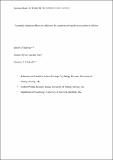Files in this item
Automatic imitation effects are influenced by experience of synchronous action in children
Item metadata
| dc.contributor.author | O'Sullivan, Eoin Patrick | |
| dc.contributor.author | Bijvoet-van den Berg,, Simone | |
| dc.contributor.author | Caldwell, Christine A | |
| dc.date.accessioned | 2020-01-17T10:30:11Z | |
| dc.date.available | 2020-01-17T10:30:11Z | |
| dc.date.issued | 2018-07 | |
| dc.identifier | 265763267 | |
| dc.identifier | 5f3d4202-8626-4f5c-9c52-5c0d87ee089d | |
| dc.identifier | 85044160950 | |
| dc.identifier.citation | O'Sullivan , E P , Bijvoet-van den Berg, S & Caldwell , C A 2018 , ' Automatic imitation effects are influenced by experience of synchronous action in children ' , Journal of Experimental Child Psychology , vol. 171 , pp. 113-130 . https://doi.org/10.1016/j.jecp.2018.01.013 | en |
| dc.identifier.issn | 0022-0965 | |
| dc.identifier.other | ORCID: /0000-0001-9380-1648/work/67526168 | |
| dc.identifier.uri | https://hdl.handle.net/10023/19300 | |
| dc.description | Eoin P. O’Sullivan was supported by a departmental studentship from the University of Stirling’s Psychology Division. | en |
| dc.description.abstract | By their fourth year of life, children are expert imitators, but it is unclear how this ability develops. One approach suggests that certain types of experience might forge associations between the sensory and motor representations of an action that may facilitate imitation at a later time. Sensorimotor experience of this sort may occur when an infant’s action is imitated by a caregiver or when socially synchronous action occurs. This learning approach, therefore, predicts that the strength of sensory–motor associations should depend on the frequency and quality of previous experience. Here, we tested this prediction by examining automatic imitation, that is, the tendency of an action stimulus to facilitate the performance of that action and interfere with the performance of an incompatible action. We required children (aged between 3 years 8 months and 7 years 11 months) to respond to actions performed by an experimenter (e.g., two hands clapping) with both compatible actions (i.e., two hands clapping) and incompatible actions (i.e., two hands waving) at different stages in the experimental procedure. As predicted by a learning account, actions thought to be performed in synchrony (i.e., clapping/waving) produced stronger automatic imitation effects when compared with actions where previous sensorimotor experience is likely to be more limited (e.g., pointing/hand closing). Furthermore, these automatic imitation effects were not found to vary with age, with both compatible and incompatible responses quickening with age. These findings suggest a role for sensorimotor experience in the development of imitative ability. | |
| dc.format.extent | 1578143 | |
| dc.language.iso | eng | |
| dc.relation.ispartof | Journal of Experimental Child Psychology | en |
| dc.subject | Automatic imitation | en |
| dc.subject | Synchrony | en |
| dc.subject | Associative sequence learning | en |
| dc.subject | Social learning | en |
| dc.subject | Sensorimotor experience | en |
| dc.subject | Social cognition | en |
| dc.subject | BF Psychology | en |
| dc.subject | NDAS | en |
| dc.subject.lcc | BF | en |
| dc.title | Automatic imitation effects are influenced by experience of synchronous action in children | en |
| dc.type | Journal article | en |
| dc.contributor.institution | University of St Andrews. School of Psychology and Neuroscience | en |
| dc.identifier.doi | 10.1016/j.jecp.2018.01.013 | |
| dc.description.status | Peer reviewed | en |
| dc.date.embargoedUntil | 2019-03-27 | |
| dc.identifier.url | http://hdl.handle.net/1893/26572 | en |
This item appears in the following Collection(s)
Items in the St Andrews Research Repository are protected by copyright, with all rights reserved, unless otherwise indicated.

